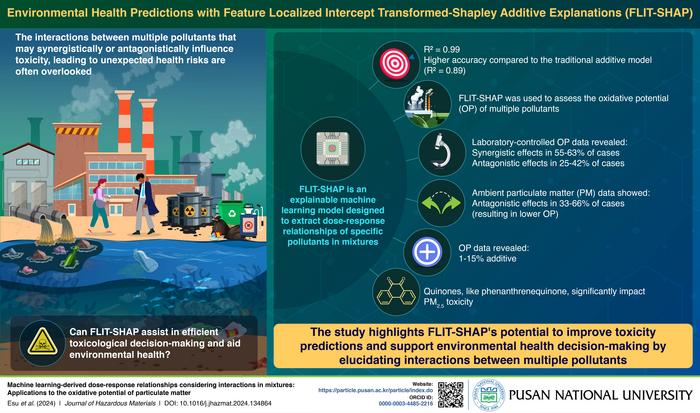Traditional environmental health research often focuses on the toxicity of single chemical exposures. However, in real-world situations, people are exposed to multiple pollutants simultaneously, which can interact in complex ways, potentially amplifying or diminishing their toxic effects. Conventional models that assume additive effects, like concentration addition and independent action, can be misleading in these scenarios. Although advanced statistical and machine learning methods have been employed to address this issue, they frequently fall short due to the complexity, high number of interacting pollutants and the inability to extract each pollutant’s absolute effect.

Credit: Professor Kuk Cho from Pusan National University, Korea
Traditional environmental health research often focuses on the toxicity of single chemical exposures. However, in real-world situations, people are exposed to multiple pollutants simultaneously, which can interact in complex ways, potentially amplifying or diminishing their toxic effects. Conventional models that assume additive effects, like concentration addition and independent action, can be misleading in these scenarios. Although advanced statistical and machine learning methods have been employed to address this issue, they frequently fall short due to the complexity, high number of interacting pollutants and the inability to extract each pollutant’s absolute effect.
To address this issue, a group of researchers led by Professor Kuk Cho from Pusan National University introduced Feature Localized Intercept Transformed-Shapley Additive Explanations (FLIT-SHAP) as a solution to these challenges. This tool is unique because it breaks down the effects of specific pollutants within a mixture, unlike traditional methods that use a broader approach. This detail-oriented technique is particularly useful for understanding the OP of particulate matter (PM) in the air, which is known to cause various health problems. This study was published in Volume 475 of the Journal of Hazardous Materials, on 14 August 2024.
“The OP of PM refers to the ability of these particles to generate reactive oxygen species, which can cause oxidative stress and inflammation in the body, leading to various health problems such as respiratory and cardiovascular diseases,” explains Prof. Cho. The scientists use FLIT-SHAP to examine the OP of these particles in a mixture of pollutants. Laboratory-controlled data was used to train robust machine learning models like eXtreme Gradient Boosting (XGBoost) and their FLIT-SHAP explanation tool was used to reveal significant insights.
“We found that in a controlled laboratory environment, 55-63% of interactions were synergistic (meaning they work together to increase toxicity), while 25-42% were antagonistic (where they counteract each other). However, in real-world scenarios, antagonistic effects were more common, leading to lower overall toxicity than predicted by older models,” added Prof. Cho.
One surprising finding was the significant impact of a group of chemicals called quinones, which showed more contribution to toxicity than previously thought. This insight challenges current approaches to regulating pollutants and suggests a greater need to focus on these chemicals. FLIT-SHAP not only predicted toxicity with remarkable accuracy (R² = 0.99) but also offered detailed insights into how different pollutants interact. This makes it a powerful tool for conducting realistic risk assessments and enhancing our understanding of environmental health risks.
The researchers’ rigorous tests uncovered how pollutants interact at varying concentrations, revealing that traditional additive models often over- or under-estimate mixture toxicity. Through FLIT-SHAP, they pinpointed crucial nuances in pollutant contributions across different environments, underscoring the need for refined risk assessments.
While the study focused on a select group of pollutants and toxicity endpoint, further research into broader scenarios is essential. FLIT-SHAP represents a significant leap forward, offering a precise tool to evaluate chemical mixture toxicity. This advancement promises better regulatory decisions to safeguard human health effectively
***
Reference
Title of original paper: Machine learning-derived dose-response relationships considering interactions in mixtures: Applications to the oxidative potential of particulate matter
Journal: Journal of Hazardous Materials
DOI: https://doi.org/10.1016/j.jhazmat.2024.134864
About the institute
Pusan National University, located in Busan, South Korea, was founded in 1946, and is now the no. 1 national university of South Korea in research and educational competency. The multi-campus university also has other smaller campuses in Yangsan, Miryang, and Ami. The university prides itself on the principles of truth, freedom, and service, and has approximately 30,000 students, 1200 professors, and 750 faculty members. The university is composed of 14 colleges (schools) and one independent division, with 103 departments in all.
Website: https://www.pusan.ac.kr/eng/Main.do
About the author
Kuk Cho is a Professor of Environmental Engineering at Pusan National University, Korea. He received his Ph.D. in Environmental Engineering from Washington University in St. Louis in 2005 and did his postdoctoral training at the University of Maryland, College Park, USA. Prof. Cho’s research focuses on innovative approaches to address atmospheric particulate matter toxicity, with emphasis on chemical species interactions affecting toxicity and chemistry. His group also develops functional materials for efficient metal ion separation from solutions. Combining environmental engineering, chemistry, and materials science, Prof. Cho’s work advances understanding of air and water pollution while developing practical environmental protection solutions.
Lab Website: https://particle.pusan.ac.kr/particle/index.do
ORCID id: 0000-0003-4485-2216
Journal
Journal of Hazardous Materials
DOI
10.1016/j.jhazmat.2024.134864
Method of Research
Experimental study
Subject of Research
Not applicable
Article Title
Machine learning-derived dose-response relationships considering interactions in mixtures: Applications to the oxidative potential of particulate matter
Article Publication Date
15-Aug-2024
COI Statement
The authors declare the following financial interests/personal relationships which may be considered as potential competing interests: Kuk Cho reports financial support was provided by National Research Foundation of Korea. If there are other authors, they declare that they have no known competing financial interests or personal relationships that could have appeared to influence the work reported in this paper.




